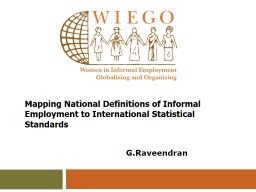

GRaveendran Characteristics of Informal Sector Unincorporated enterprises No complete accounts permitting a financial separation of production activities of the enterprise ID: 1028346
Download Presentation The PPT/PDF document "Mapping National Definitions of Informal..." is the property of its rightful owner. Permission is granted to download and print the materials on this web site for personal, non-commercial use only, and to display it on your personal computer provided you do not modify the materials and that you retain all copyright notices contained in the materials. By downloading content from our website, you accept the terms of this agreement.
1. Mapping National Definitions of Informal Employment to International Statistical Standards G.Raveendran
2. Characteristics of Informal SectorUn-incorporated enterprisesNo complete accounts permitting a financial separation of production activities of the enterpriseAt least some part of the goods or services for sale or barter Employment size below a certain thresholdAnd/or not registered under specific form national legislation
3. Characteristics of Informal EmploymentThe employment relationship, in law or in practice not subjected toLabour legislationIncome taxationSocial protection, orEntitlement to certain employment benefitsInformal employment exist even outside the informal sector
4. Informal EconomyConsists of both the informal sector and informal employment outside informal sector
5. National AdaptationsAll the listed criteria are not necessary Choice of criteria by countries depend on many factorsNational priority and perceptionPolicies on informal economyLegal frameworkStatistical systemIndependence and discriminant power of variables
6. South AfricaRegistration with VAT and/or Income tax authorities is used to distinguish between formal and informal enterprisesThe self employed are asked the direct question about registration with VAT/ IT authorities and employees were asked whether their employer deduct IT from their pay
7. South Africa -- ContdQuestions on employment contract and contribution to pension fund, etc. are used to identify informal worker
8. Indian Criteria for Informal SectorLegal status Proprietary and partnership firms in India do not have any separate legal status other than that of the owners. Thus such units are considered as un-incorporated.Size of employment. The second criteria employed for the identification of informal sector was employment size of fewer than 10 workers
9. Indian Criteria for Informal Sector -- ContdThe size criteria was decided after analysing the threshold limits of various labour laws, productivity differentials of establishments with different employment sizes and development policies.Maintenance of complete accounts criteria is implicit as there is no requirement of private establishments employing less than 10 workers to maintain such accounts
10. Indian Criteria for Informal Sector -- ContdRegistrationThe criterion of registration was not explicitly used as there were multiple registrations of firms and there was no single registration system covering all firms and giving separate legal status to all the registered units. Nevertheless, by considering only proprietary and partnership enterprises, those registered under different acts which give them separate legal status are excluded from the informal sector.
11. Identification of Informal Workers in IndiaCategory of workerFormal sectorInformal sectorHHsEmployerFormalInformalXOwn account workerFormalInformalXUnpaid family workerInformalInformalXCasual workerInformalInformalInformalRegular worker with no social securityInformalInformalInformalRegular with social securityFormalFormalFormal
12. International Comparability IssuesDefinitional Issues – worker / non-workerUse of varying criteria for identification of informal sector/ informal workerVarying cut-off points for employment sizeDifferences in coverageEconomic activities, domestic workersProducers of goods exclusivity for own final useSecondary jobsPersons engaged in professional or technical activities
13. Recommendations of Delhi Group - Informal SectorAll countries should use the criteria of legal organization (unincorporated enterprises) of type of accounts (no complete set of accounts) and of product destination ( at least some market output Include persons engaged in professional or technical activities and paid domestic services
14. Recommendations of Delhi Group - Informal Sector .. ContdProduce tables using employment size criteria of fewer than five employees.Produce cross tabulations by using employment size criterion and registration as well as agriculture and non-agricultural activities
15. Can there be Internationally Comparable Data on Informal EconomyDelhi Group recommendations seek to get internationally comparable data at least for one segment of informal sector workers.Unless comparability of estimates of informal sector workers is achieved, comparability of informal economy is not feasible.Given the diversity of economic activities and variations in identification criteria across the countries, it is impossible to achieve perfect comparability
16. WIEGO